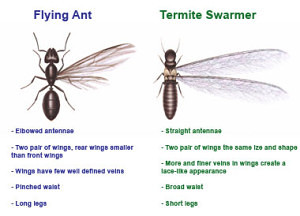Termite
Imagine you were planning a picnic on a nice summer day. However, just before you head out the door, you are notified that there is a high chance of a rainstorm.
Now, a storm isn’t guaranteed. It’s just a warning. But would you still go out for your picnic that day? Probably not.
Termite swarms are like storm warnings. They don’t guarantee your home is infested, but if you see swarming around your property, you better watch out!
But what IS a termite swarm?
A termite swarm is a large horde of winged termites that are released in response to certain environmental triggers.
This horde of winged termites, known as alates, are the future kings and queens of new termite colonies. They emerge from their nests through small cracks and tubes in the soil to mate with other alates.
The vast majority of these alates will die from either environmental conditions, pesticides, or predators. Those that survive, however, pair up to mate.
Once paired, these “royal couples” burrow underground and begin laying eggs. These eggs will eventually become the first generation of termite workers in a new colony.
What triggers a termite swarm?
Termite swarms can be triggered by both natural and artificial changes in the environment.
Generally speaking, it takes at least 4 years before a colony can produce swarmers if conditions are favorable. The swarm cycle occurs naturally as a way to expand the termite colony and spread the population throughout the surrounding area.
But this is not the only reason that termites will swarm. Disruptive factors can also be an impetus. For example, a dwindling supply of food or water can trigger a swarm.
Another possible trigger is the application of certain pesticides. A synthetic pyrethroid termiticide, which repels termites from a structure, can cut off a colony from sources of food or moisture. This can result in swarming if the termites are unable to locate a suitable alternative.
In short, termites swarm naturally in a cycle, but they also may swarm if the survival of the colony is threatened.
When does swarming occur?
Termite colonies have a different swarm season depending on their geographic location and the species in question.
In Georgia and other southeastern states, swarm season typically occurs between January and May for Eastern Subterranean termites.
Eastern subterranean termites typically swarm during the day, but Formosan termites tend to swarm in the evenings during late spring or early summer.
While these patterns are fairly consistent, fluctuations in rainfall or temperature can change swarming behavior.
I found swarmers around my home, should I be concerned?
A few dead swarmers are not necessarily confirmation of a termite infestation. Even if you find the pests inside, it is always possible that they just found a way indoors.
Unlike workers, swarmers do not feed on wood or other cellulosic materials. So they aren’t a threat to you beyond being a nuisance.
However, swarmers in and around the home do guarantee the presence of a colony that is near to your home. It may not be inside, but it would still be prudent to have your home inspected by a pest management professional.
Termites are a tenacious pest. An untreated home is at constant risk of infestation even if it currently has no termite problems.
It is critical to ensure your home is protected against the threat of termites. The damage they cause can cost you thousands and may permanently lower the value of the structure.
Protecting your home against termites:
At Canton Termite and Pest Control, we use only the highest quality products to protect you against pest threats.
Repellant products can agitate termites and become the impetus for swarming. Due to this shortcoming, we instead employ a non-repellant Termidor product.
The best description of the product comes from the makers themselves: “Termidor kills termites through ingestion, contact, and through ‘The Transfer Effect™.’ The active ingredient in Termidor-fipronil-is slow-acting and allows the termite to continue its normal routine… the termite remains active long enough to transfer the termiticide to a large number of other termites before dying itself.”
In short, the product is spread exponentially throughout the colony. This quickly eliminates the bulk of the termite population and gets the infestation under control.
With decades of experience in the pest control industry, I don’t choose products for my business lightly. I have employed Termidor for years because it has remained a top-tier treatment product.
Additionally, the new Termidor HP2 Injection System takes our termite treatments to the next level. This system injects treatment from the soil surface down to where termites roam. This means that trenching won’t be necessary AND that treatment can be applied in a fraction of the time.
It’s less labor-intensive, uses significantly less water, and ensures a perfect treatment quantity each time using the onboard computer system.
In short, it’s the cutting edge of termite control.
This is just one example of how Canton Termite and Pest Control keeps up to date on the latest innovations in the pet industry.
If you are in need of cutting-edge pest control solutions without sacrificing the warmth and customer service of a local company, there is no better choice than Canton Termite and Pest Control!
Give us a call TODAY at 770-479-1598 to learn more!
P.S. Ask about our FREE 58 point pest inspection!
By: Tim
